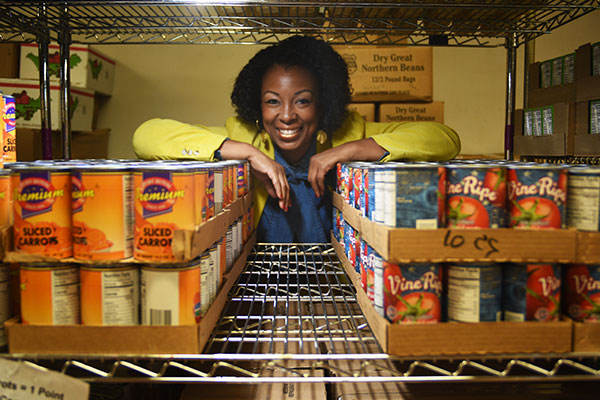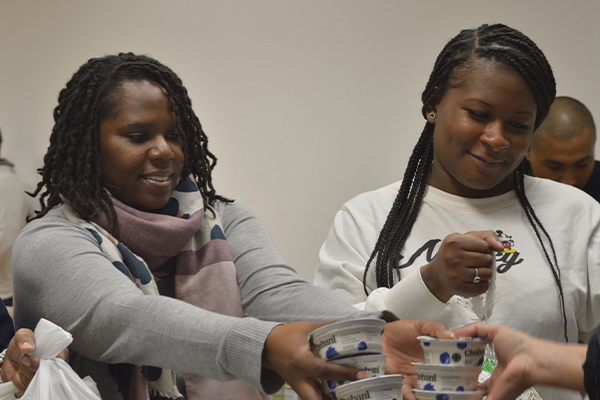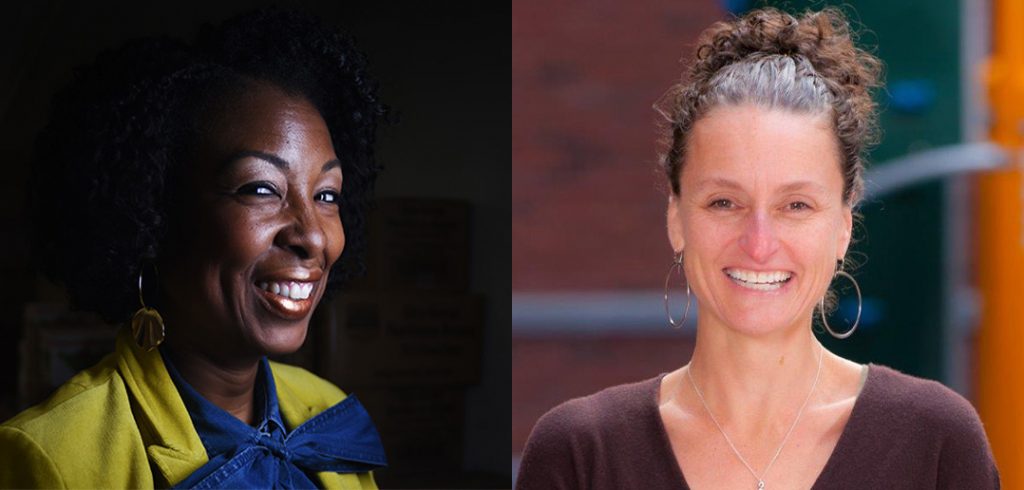Camesha Grant, Ph.D., GSS ’00, ’07
Vice President of Community Connection and Reach
Food Bank for New York City
The Food Bank for New York City not only operates its own soup kitchen and food pantry in Harlem and a warehouse in the Bronx, but it also has a network of more than 1,000 charities and schools to help provide 62.5 million meals each year. Combined, these pantries see an average of 1.5 million New Yorkers per year, based on numbers prior to the COVID-19 pandemic.
How has your day-to-day work changed since the outbreak began?
A lot of my work involves going out into the community, connecting with those on the front lines in our soup kitchens and our pantries. Also, building and establishing new partnerships with organizations across the city to really be able to meet the need where it is as it relates to emergency food. So my work looks really, really different now because I am working from home.
About 40% of the soup kitchens and food pantries in Food Bank for New York City’s network have closed as a result of the COVID-19 pandemic. And that means that the communities where those pantries and soup kitchens once existed now have gaps in terms of emergency food. So we’ve been really strategically working to get into those communities by getting food and additional resources to some of the partners who are still open. Some of our agencies have mobile pantries and can move food differently throughout the city. And so we have been working to get them more food on the ground as well.
How do things look different now at the pantries that are still open?
One of the things that they’ve done is shifted to a grab-and-go model. So, generally, we would have all of our pantries practice what we call “client choice.” Client choice is the ability for any individual who is food insecure to go in and shop for the food items that they want. Now our clients are no longer able to come into the pantry spaces, and all of our soup kitchens are pre-packing bags of groceries. It takes away, obviously, the ability to choose and decreases the dignity in that process, because we want clients to be able to feel like they’re shopping in a supermarket. So that’s been one real change.
Have clients have been understanding of these changes?
The clients are definitely understanding of the changes that we’ve had to make. I think they appreciate that we are working to ensure social distancing. Food Bank for New York City has been working with our network of soup kitchens and pantries around how to set your pantry up in this new COVID-19 world. So we provided guidance around social distancing, outdoor setups, additional equipment like tables and gloves and masks. We have been able to provide some PPE equipment to our pantries. We’ve also been able to get them bags, a huge resource right now because they’re packing so many bags to go for families. Clients are certainly appreciative of the steps that we’ve taken. I think they recognize that it’s about their safety as well. No one wants to be standing on a line right now.
With so many people out of work right now, we’re also seeing a new wave of New Yorkers who are forced to join the pantry lines. And so these are people who are new to our space. They don’t really understand how the Food Bank and how food pantries run. And so for them, there’s no comparison. They’re just there, and they’re getting what they need. And they’re happy to be able to do that.

I know that normally the Food Bank, in addition to overseeing pantries, also does educational programs and helps clients apply for SNAP and other benefits. Has the capacity still been there for the Food Bank to do that?
We are still doing our benefits work remotely. We’re able to engage New Yorkers over the phone who are interested in applying for SNAP (Supplemental Nutrition Assistance Program) benefits. We are working on a platform for virtual nutrition education with schools being closed. One of the programs that we run is called CookShop, and it is nutrition education for children in schools, and that curricula is administered by teachers. And so we have been in conversation with the Department of Education, and we’re still looking at ways that we might be able to continue that programming.
Have you experienced any positive moments or moments of hope you could tell us about?
I’d say a couple of things. We made a decision a few weeks back to stop having volunteers come in [to our Harlem food pantry and Bronx warehouse]. We really wanted to, just for the safety of everyone, minimize the number of people that were in our space. But we also wanted to still be able to engage New Yorkers. So we started a campaign that allows New Yorkers to write notes to our clients. And those notes are just notes of hope, notes of encouragement, and they are placed in the pantry bags. I think that that’s really encouraging, that so many New Yorkers are interested in wanting to just say a few kind words to those who are struggling right now with food insecurity.
I think other examples are really just hearing from different types of organizations that we haven’t worked with before. We are currently partnering with NYC Health + Hospitals, and Food Bank for New York City has been able to distribute food, grocery bags, and hygiene bags to the front line workers. They’ve been extremely excited to have a bag of groceries at the end of the shift. They don’t have the time after working really long shifts to go into a supermarket, to stand on lines to shop for their families.
And we’ve also been in partnership with the New York City Housing Authority (NYCHA). Low-income families primarily reside in New York City housing, and we’ve worked with NYCHA to host what we call pop-up pantries in probably over 20 locations to date since COVID-19. We take in truckloads of food, set up right on a sidewalk, a pop-up pantry where those families can just come out of their apartments, join a line, and leave with a bag of groceries all for free.
How is the Food Bank planning for the long-term changes that are going to have to occur because of this?
We’re collecting a lot of data right now on the ground. We surveyed our members in our network. One of the things we know for sure is that we can’t go back to business as usual. The emergency feeding network will look different. We don’t know how many of our members will reopen, with 40% of them now currently being closed. So we have to prepare for creative and innovative ways to ensure that emergency food is still available in those communities.
Is there anything else that you would like the public to know about the overlap between the public health crisis and food insecurity?
I think that people across the country are experiencing fear and uncertainty right now, but that’s especially magnified for low-income families and vulnerable populations. And the coronavirus has also become a food insecurity issue for millions of low-income seniors, including 350,000 right here in New York City who rely on emergency food.
So while public health officials recommend that seniors stay home and avoid group activities, that fails to address the daily struggle of low-income seniors who lack access to healthy foods and who cannot afford to stock up on groceries. And I don’t know that that issue is really one that we are addressing in a way that we need to. At Food Bank for New York City, we’re doing what we can to ensure that those seniors are getting their needs met. I know the Department for the Aging is also supporting that, but there’s a huge crisis there when you think about seniors who are not coming out of their homes, many who live alone, many who are unable to cook for themselves, many who are on fixed incomes, and again don’t have the ability to stock groceries or shop for food. It really has become a food security crisis for that population.
Janet Miller, GSS ’97
Senior Vice President, CAMBA
As senior vice president at CAMBA, a Brooklyn-based nonprofit that provides social services to New Yorkers in need, Janet Miller, GSS ’97, oversees the organization’s food and nutrition programs, including its Beyond Hunger Emergency Food Pantry in Flatbush.
During normal times, what work does CAMBA do to address food security issues in New York City?
Besides routinely providing clients with bags of groceries to last three days, CAMBA’s Beyond Hunger Emergency Food Pantry provides nutrition education that has included cooking demonstrations and sharing recipes for wholesome meals; assists people with applications for public assistance, such as SNAP benefits, previously known as “food stamps”; and also provides information and referrals to money management, social service programs, and health care providers, as needed. CAMBA also has our Food and Nutrition Services Program for People Living with HIV/AIDS and our Healthy Families Program.
How has that work changed since the beginning of the COVID-19 pandemic? Are you seeing a significant increase in need?
On average, our food pantry serves about 300 clients a week, but during the week of April 13, about 400 people sought assistance. And on one day [in April], there were almost 300 people who used the pantry. We anticipate that these numbers will continue to grow, because other food pantries have had to suspend their services, and open pantries like ours will absorb these growing numbers. And of course more people have lost their jobs or sources of income that help pay for food and rent.
Where are you seeing the biggest shortages or challenges during this time?
One immediate change is we currently are not able to offer additional help with nutrition education and have limited capacity to help with applications for other types of assistance, as the numbers of people needing food keeps increasing. There are fewer volunteers as people are self-isolating and that means fewer workers to assist with the increased distribution. We have masks and gloves—but can always use more—and we practice social distancing during our process. Whereas we previously encouraged clients to “shop our pantry” and pick out what they want, we’re now pre-packing food for everyone. Previously, we would provide three days of groceries to tide clients over between our pantry days (Tuesday and Thursday), but now we’re trying to pack bags that contain groceries for one to two weeks so clients have to make fewer visits during this pandemic.
The challenge will be continuing to provide food for the increased numbers of people seeking help. We’ll need more donations to buy the products; certainly, we don’t want to run out of food.

What kind of systems are in place to get food to people who can’t leave their homes or places of shelter?
We refer people to the NYC.gov site that lists various resources for food delivery assistance. Here they will also find locations for other food pantries. The NYC schools are also providing food for New Yorkers at 400 different locations.
Long-term, will the pandemic change anything about the way CAMBA’s food pantry operates? Are social-distancing-minded practices something that can be adapted to the food pantry model?
We already have an orderly distribution process where one guest at a time is able to do her “shopping.” We hope to return to providing our previous range of services to address the underlying challenges that bring our clients to a food pantry.
What can alumni both in NYC and elsewhere do to help address food security issues in their communities, both during the pandemic and after?
We would encourage people to donate time or money to organizations that work with food insecurity issues. In New York City, those interested in volunteering can go to the NYC Service website. Check online or call before offering to volunteer at any food pantry, as there may be a formal process for bringing on volunteers.
People should also consider advocating for more federal assistance on this issue—that there be no cuts or severe restrictions to SNAP and other food programs. No one should go hungry in this country. Food insecurity was a problem before the COVID-19 pandemic, and will remain an issue after we progress beyond current constraints. Even if things get better, people will still be hungry. That should not be.

